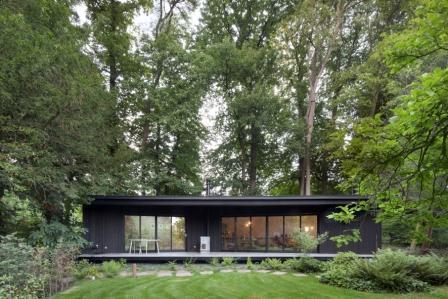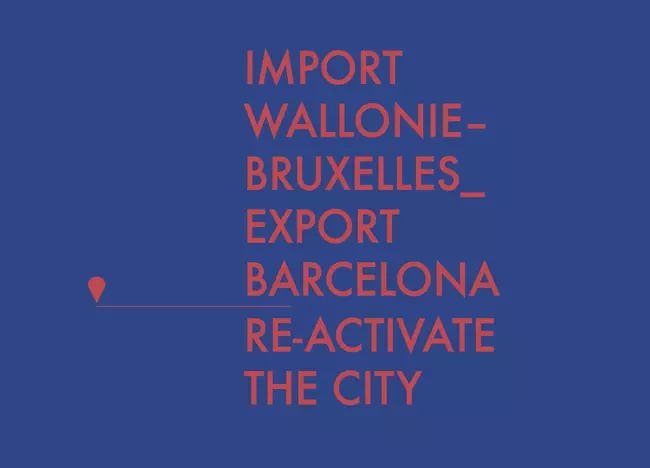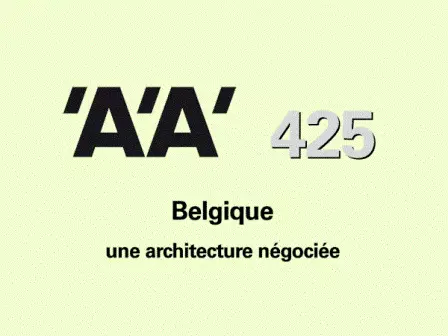- PostsSite Internet
Published on 23/11/2015
entrer: Vers.A - "A garden pavilion?"

© Maxime Delvaux By containing an almost schizophrenic programme in a sober architecture nestled in the Flemish Ardennes, the architects of Vers.A added 'spiritual elan' to the preconceived idea of the garden pavilion.
A garden pavilion? The timber construction should not be regarded, as its appearance suggests, as a small annex or refuge secluded among the trees. Its floor area is even larger than the admittedly modest villa from 1938 that stands next to it in the park-like grounds and was originally constructed for a single dancer. To grasp the real purpose of this new building, it is first of all important to know the background. The owner had a vision of building a second house that would provide extra space not only for parts of his extensive collection of contemporary art, but also for his books and art catalogues. It was also essential for him to have a superbly equipped kitchen, as his wife is a talented cook and the pavilion would be used for entertaining guests. In addition, it should provide an opportunity for retreat. These mixed uses presented a certain difficulty which called for a special architectural-conceptual idea.
We are standing at the edge of a large expanse of green with an adjoining pond that extends in front of the villa. Towards the west, the terrain stops abruptly next to the pavilion. From here one can follow small paths through a thick beech grove down into a deep valley. Originally, this specific topography was to have considerably more influence on the design of the pavilion. Three floors were proposed. The lowest, partly buried below the surface, was to offer a view into the dark valley. A bedroom was planned in the smaller part of the building superimposed on the ground floor. This first design was not implemented for urbanistic reasons. The pavilion as built has only one level that stands out on a floor slab. Clearly oriented, it has a largely enclosed rear wall facing north, where the access road to the property is located, and a generously designed south side with full room-height openings. A roof protects the front terrace.
Two years were needed to coordinate the plans with the ownerbuilder. Considerable time passed without anything happening. This surely had to do with the fact that the owner had a passion for architecture and in earlier years even wanted to become an architect himself. A keen observer of the construction scene in Flanders and beyond, he is well-informed on current developments. This raises the question of how he happened on the young Brussels-based architectural team Vers.A.
Only a few steps from his villa he discovered a house which, although of conventional design with a gable roof, exhibited a series of architectural refinements. He enquired about the Vers.A architects and it turned out that one of the two partners, Kobe Van Praet, was a former employee of Robbrecht & Daem. With the latter the owner had once remodelled his house in the neighbouring town of Oudenaarde over the course of eight years to accommodate his art collection. In addition, 15 years earlier Robbrecht & Daem had built a small enchanting hut for him made of simple wooden blocks in the valley with the beech grove. About that time the owner made the acquaintance of Paul Robbrecht in the art scene. And so the circle closes.
The pavilion is also made entirely of wood, but in a distinct manifestation. Its exterior is faced with dark oiled pinewood. The wooden supports place a subtle emphasis on the structure of the facade in an 80 cm grid. The house is well insulated. It is anticipated that on cold winter days the occupants will prefer to stay here in the pavilion rather than in the villa. The zinc roof projects discreetly above the facade to form a restrained edge. The building is accessed via a rear door and small lobby with a toilet and shower, and a second entrance next to the kitchen on the western face. To enter the raised house one must step onto large, roughly hewn stone blocks from a nearby quarry.
The architectural-conceptual idea with regard to the various uses manifests itself in the building's interior. All walls and the ceiling are faced with light-coloured multiplex panels. This internal covering of the room is to be seen as a continuum and conceals a series of carefully prepared details that enable changes to be made very flexibly according to requirements.
The quality of the space is therefore the manner in which it can be used as a container for a variety of things. Besides the kitchen cooker, various other areas can also be sectioned off with folding walls. Plain walls that lend the room the character of an exhibition space can be created in only a few simple actions. Even mounts for pictures have been fitted in the four wall elements. Curtains and a roller blind at the windows are concealed behind the multiplex wall as a projection wall. Even the fireplace opening is surrounded by panels. The panelling continues in a low fixture with a shelf into which the highly detailed ribs of the radiators behind it have been cut, and ends in a seating corner. In the slightly inclined ceiling, the two irregular rectangular apertures are crucial for introducing light into the room in the densely vegetated surroundings. The pavilion draws its strength from the great architectural uniformity and changeability it playfully communicates. Everything can be explained and yet the interior also conceals surprises. Sometimes one wonders whether or not certain wooden elements can be opened by pressing and turning.
The inner body and facade with the terrace hold additional suspense by being slightly angled. This enables the space to be subdivided as the occasion arises, e.g. with different uses, to create two distinct sections – a simple yet decisive architectural gesture.
Embedded in the landscape of the Flemish Ardennes near Renaix, the spiritual impulse in this garden pavilion was the concept of space, effect and utility. For the owner, the most important aspects today are nature, the atmospheric wealth of this location and its emotional perception in conjunction with its art.Written by Sebastian Redecke within the framework of the publication entrer: which completes the eponym exhibition.
- BilletsAuteur
Audrey ContessePublished on 09/10/2018
-
Allier procédure et processus
"La scène belge est gage de qualité, d’humanisme et de poésie" peut-on lire dans le numéro 425 de l’Architecture d’Aujourd’ hui, dévolu à l [...]
- BilletsAuteur
Emmanuelle BornePublished on 06/07/2018
-
Belgitopie
Faut-il se fier aux expositions internationales, a fortiori à la Biennale d’architecture de Venise, pour appréhender les mouvements de fond et enjeux [...]



